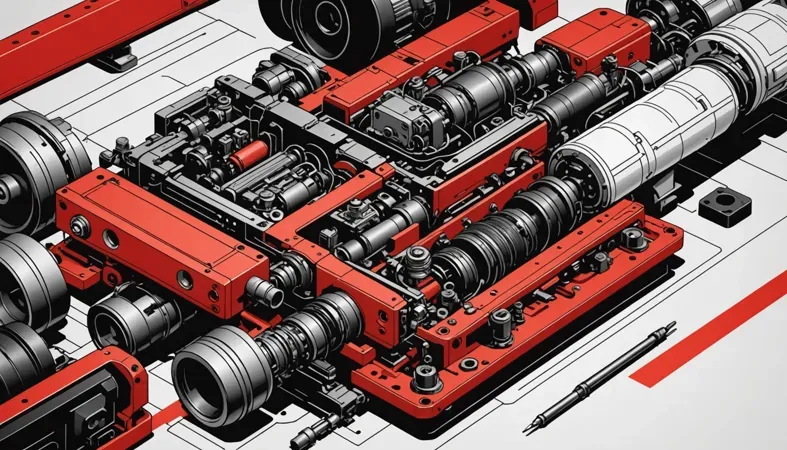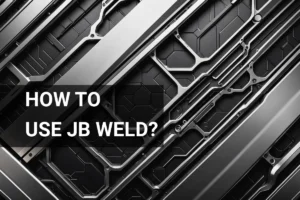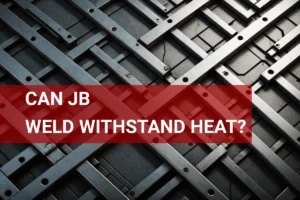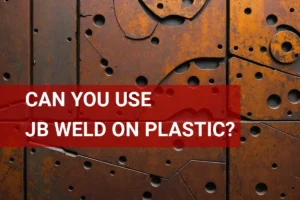How Strong is JB Weld? Strength, Types, and Applications
Published on: April 3, 2025 | Last modified: March 4, 2025
By: Tyler James
JB Weld is a popular epoxy adhesive used for bonding metal, plastic, and other materials. It’s known for its durability and strength.
I get asked quite often, how strong is jb weld? This question is vital because knowing its strength can help you choose the right applications. From my experience, using JB Weld correctly can lead to long-lasting repairs, but it’s important to follow the right steps.
In this article, you’ll discover the types of JB Weld, necessary prerequisites, steps for use, safety tips, types of strength for JB Weld, factors affecting bonding, common issues, aftercare, advantages, and possible alternatives. You’ll also delve into the query, how strong is jb weld on steel, and learn everything you need to know about using this amazing product effectively.
Contents
- How Strong is JB Weld?
- What is JB Weld?
- Types Of JB Weld
- Prerequisites
- Steps to Use JB Weld
- Safety Tips
- Types Of Strength for JB Weld
- Factors Affecting JB Weld Bonding
- What Could Go Wrong: Common Issues
- Why This is Worth It: Advantages
- Typical Applications
- Performance Comparisons: JB Weld vs. Competitors
- Are There Any Alternatives to JB Weld?
- Frequently Asked Questions (FAQs)
- Conclusion
- References
How Strong is JB Weld?
JB Weld is a two-part epoxy adhesive, so how strong is JB Weld? It can withstand up to 5040 psi (34.7 Mpa), making it great for metal repairs. It’s tough to apply on vertical surfaces; ideal for automotive and plumbing fixes.
What is JB Weld?
JB Weld is a high-strength epoxy adhesive, known for bonding metal, wood, and plastic. It consists of two parts: a resin and a hardener, typically mixed in equal parts by volume. Once applied, the mixture cures into a tough, steel-reinforced bond. It can withstand temperatures up to 260°C (500°F) after curing, which takes about 4-6 hours at room temperature.
So, how strong is JB Weld? Many swear by its strength and durability. I’ve used it for a few automotive repairs, and it held up impressively. It’s like magic: once set, it becomes a permanent bond you can rely on.
For work, I used it on a cracked aluminum frame. JB Weld transformed the repair. I found the bond to be highly reliable, resisting up to 24,800 kPa (3,600 Psi) of pressure once fully cured. This performance made me wonder: what is the strongest JB Weld? It truly excelled in situations requiring robust solutions.

Types Of JB Weld
-
JB Weld Original
This classic formula is perfect for general repairs. It forms a bond of about 3960 psi (Pounds Per Square Inch). To achieve this strength, mix it well and apply it evenly to clean surfaces.
-
JB Weld Kwik
This version sets quickly, in about 4-6 minutes, with a bond strength of roughly 2420 psi. For best adherence, keep surfaces tightly together while it cures.
-
JB Weld Clearweld
This transparent option is ideal for glass and ceramics, reaching about 2300 psi. For a strong bond, apply it thinly and allow it to cure fully before applying stress.
-
JB Weld Hightemp
This type withstands temperatures up to 500°F (260°C) and achieves a bond strength of about 4000 psi. For maximum durability, apply it in a well-ventilated area and let it cure completely at room temperature.
-
JB Weld Epoxy Putty
This putty is easy to mold for odd-shaped repairs, with a bonding strength of about 900 psi. To use it correctly, knead it well and press it firmly into the joint.
We’ve wrapped up various types of JB Weld here. Next up, we’ll look at the necessary prerequisites.
Prerequisites
What do you need to get started with JB Weld?
- JB Weld Original Epoxy: Get the standard product, like the JB Weld 2 oz tube. It’s essential for bonding metal surfaces, rated for up to 3950 psi (27.2 Mpa).
- Surface Cleaner: Use a product like 3M General Purpose Adhesive Cleaner. Clean surfaces ensure a better bond, enhancing JB Weld’s effectiveness on metals.
- Mixing Stick: Grab a wooden stick, such as a craft popsicle stick. It’s essential for thoroughly mixing the epoxy to activate its strength.
- Clamps or Weights: Use clamps, like Irwin Quick Grip, to secure the joint for strong adhesion, maintaining pressure as it cures for at least 4-6 hours.
So far we covered the necessary prerequisites for using JB Weld. Next, let’s look at the steps to apply it effectively.
Steps to Use JB Weld
We’ll cover steps to maximize JB Weld’s strength on various materials.
-
Prepare the Surface
Clean the surface you’re fixing. Use a wire brush or sandpaper to remove rust, paint, or dirt—this helps JB Weld adhere better. Create a smooth, uniform surface area that’s at least 0.5-1 mm (0.02-0.04 In) rough. A better surface means a stronger bond!
-
Mix the JB Weld
Take equal parts of the hardener and the resin. Use a clean mixing tool to blend them well. Mix thoroughly for about 2-3 minutes until you achieve a uniform color. The result? A strong adhesive that’ll withstand stress, typically curing up to 4000 psi (27.6 Mpa).
-
Apply the JB Weld
Scoop up the mixed JB Weld and apply it directly to the prepared area. Use a small putty knife for better control. Ensuring even pressure distributes the weld across the surface aids strength. Don’t be shy; apply extra to any gaps, as it’ll clamp down and seal the area under pressure.
For projects requiring certified techniques, understanding B pressure welding methods could enhance the durability and quality of the weld.
-
Let It Cure
Allow JB Weld to cure undisturbed for at least 4-6 hours; however, wait 15-24 hours for maximum strength. The curing temperature matters; ideal conditions are around 21°C (70°F). Avoid moving or stressing the bond during this phase for optimal results!
Mastering different welding techniques requires understanding specific methods such as how to weld uphill.
We covered the process for using JB Weld and essential tips. Next, we will cover important safety precautions.
Safety Tips
Let’s quickly review essential precautions for understanding how strong JB Weld is.
- Ventilation: Proper airflow reduces fumes. Use JB Weld in open spaces, like garages.
- Protective Gear: Always wear gloves and goggles to protect your eyes and skin. I recommend safety glasses for maximum protection.
- Mixing Ratios: Follow recommended volumes for optimal bonding strength. For JB Weld, mix equal parts by weight; 1:1 is crucial.
- Storage: Keep JB Weld cool and dry for a longer shelf life. Sealed containers can last over 2 years!
Always prioritize safety for successful results!
We have now covered safety tips. Next, we will examine the different types of strength for JB Weld.
Types Of Strength for JB Weld
Let’s look at the types of strength for JB Weld: Shear Strength, Tensile Strength, Impact Resistance, Compressive Strength, and Flexural Strength.
-
Shear Strength
Shear strength measures how well JB Weld handles forces that slide one part over another. For JB Weld, this strength can reach about 2,460 psi (16.95 Mpa) for steel-to-steel applications. It’s crucial for loads that pull perpendicular to the bond.
-
Tensile Strength
Tensile strength shows how well JB Weld resists being pulled apart. On average, it can hold up to 3,960 psi (27.3 Mpa). This makes it ideal for bonding aluminum and metal, which require strength under tension.
-
Impact Resistance
Impact resistance indicates how well JB Weld withstands sudden forces or shocks. It doesn’t just break at the first hit; some JB Weld products can resist impacts, making them reliable for machinery repairs. This toughness saves you time and frustration.
-
Compressive Strength
Compressive strength tells us how much load JB Weld can handle before crushing. Its strength can reach about 9,000 psi (62 Mpa). This feature is useful for bonding heavy parts where weight matters.
-
Flexural Strength
Flexural strength measures how well JB Weld resists bending or breaking under applied forces. It typically shows around 3,700 psi (25.5 Mpa). In this regard, JB Weld works well for flexural situations, which many users often overlook.
Factors Affecting JB Weld Bonding
What factors impact JB Weld’s strength? Here’s a closer look.
-
Surface Preparation
Clean surfaces enhance adhesion. Dirt, oil, or rust reduce bonding strength, causing weak spots. Always prepare surfaces by sanding or cleaning with a degreaser.
-
Ambient Temperature
Temperature plays a vital role in curing. JB Weld works best between 40°F (4°C) and 100°F (38°C). Outside this range, bonding quality may decline, so keep it warm.
-
Curing Time
I’ve experienced issues with curing time. JB Weld typically requires 15-24 hours to set properly. Rushing this process may weaken the bond. Full strength develops in about 72 hours.
-
Thickness Of Application
Thicker layers may take longer to set and may not cure evenly. A layer thicker than 1/8 inch (3.18 Mm) can trap solvents, weakening the bond. Stick to optimal thickness for best results.
-
Type Of Material
JB Weld’s strength varies by material. Its epoxy is strong on steel and aluminum but weaker on plastics. Testing your specific materials ensures optimal performance.
What Could Go Wrong: Common Issues
Here are common issues unique to JB Weld.
-
Incomplete Curing
JB Weld needs a full cure of 4-6 hours. If it isn’t fully cured, it’ll break easily. Check by poking; if it feels soft, wait longer. Ensure the ambient temperature is above 24°C (75°F).
-
Poor Surface Preparation
JB Weld requires clean surfaces. Grease or rust prevents adhesion. Rough up the area and clean with acetone for a secure bond.
-
Excessive Moisture
Too much moisture can weaken JB Weld. Wet surfaces reduce its effectiveness. Use dry rags before application and let it dry for at least one hour.
-
Improper Mixing
JB Weld requires precise mixing. An incorrect ratio makes it ineffective. Mix thoroughly for a solid bond and avoid clumping, which signals improper mixing.
-
Overstressing the Bond
JB Weld can handle up to 3,960 psi (27.3 Mpa). Don’t apply stress too early. Wait a full 24 hours to ensure it holds tight.
Why This is Worth It: Advantages
The main benefit of JB Weld is its incredible bonding strength. I used it to repair a broken metal bracket, and it easily handled heavy loads.
Moreover, it’s versatile, working on aluminum, steel, and other metals. It resists water, heat, and chemicals, making it ideal for tough repairs. Plus, it sets quickly, curing in about 4-6 hours at room temperature (Around 21°C or 70°F). Lastly, it’s easy to use, requiring no special tools for mixing or application!
Typical Applications
I’ve seen people use JB Weld for quick fixes, but it also has many practical applications, such as:
- Automotive Repairs: JB Weld seals cracked engine blocks. It’s popular because it withstands high temperatures and pressure.
- Pipelines and Plumbing: It fixes leaks in metal pipes and is preferred for its strong bond and waterproof properties.
- Heavy Machinery Components: Many use it to attach metal parts in heavy machinery. Its durability under stress makes it a go-to choice.
- Aerospace Applications: Technicians bond metal parts in small aircraft. Its lightweight, durable nature is essential for reducing weight without losing strength.

Performance Comparisons: JB Weld vs. Competitors
Let’s take a look at how JB Weld stacks up against other popular adhesives.
| Product | Tensile Strength (psi) | Temperature Resistance (°F / °C) | Cure Time | Applications |
|---|---|---|---|---|
| JB Weld Original | 3,960 psi (27.3 Mpa) | 500°F (260°C) | 4-6 hours to initial set | Metal, Wood, Plastic |
| Loctite Epoxy Weld | 4,000 psi (27.6 Mpa) | 300°F (149°C) | 20-25 minutes | Metal, Plastic |
| Gorilla Super Glue | 2,000 psi (13.8 Mpa) | 180°F (82°C) | 10-30 seconds | Wood, Rubber, Ceramics |
| Permatex Epoxy | 3,300 psi (22.8 Mpa) | 300°F (149°C) | 4-6 hours | Metal, Plastic, Wood |
As you can see, JB Weld offers impressive tensile strength, making it a strong choice for various applications. When deciding what to use, consider the specific needs of your project. JB Weld excels in high-temperature environments and can endure significant stress, setting it apart from alternatives. It’s crucial to be aware of potential health hazards in welding, especially concerning materials like galvanized steel safety risks.
Are There Any Alternatives to JB Weld?
Several alternatives exist for achieving strong bonding results. You might consider products like Loctite Epoxy Weld or Gorilla Super Glue for certain applications. I’ve often found myself thinking that these options can be superior for specific materials, such as aluminum or plastic.
Some folks prefer using epoxy adhesives, like Devcon or Permatex, which can offer good results on metals and plastics too. They cure quickly and often have versatile applications. They’re handy when you need a precise bond and have less time to wait compared to JB Weld.
Frequently Asked Questions (FAQs)
Here are some unique questions I typically get asked about JB Weld:
Is J-B Weld Really Strong?
Yes, J-B Weld is known for its impressive strength. J-B Weld can hold up to 1,200 psi when fully cured, making it an excellent adhesive for many surfaces.
How Many Pounds Of Force Can J-B Weld Hold?
J-B Weld can hold around 8,000 pounds per square inch (Psi). This immense strength allows it to repair items that experience significant stress or pressure.
Is J-B Weld a Permanent Fix?
Yes, J-B Weld is considered a permanent fix. Once cured, it can withstand extreme temperatures and harsh conditions, offering a long-lasting solution for bonding materials.
Is J-B Weld Load Bearing?
Absolutely, J-B Weld is load bearing. It can tolerate various stress loads, making it suitable for applications where support is critical, like automotive repairs.
What is the Strongest JB Weld?
The strongest JB Weld is the JB Weld Extreme Rated version. It has a tensile strength of 5,000 psi when fully cured, which is higher than regular JB Weld, making it perfect for heavy-duty applications. For those looking for options beyond traditional adhesives, exploring welding alternatives can provide additional solutions.
To explore techniques for effectively joining metal, you can discover how to forge weld steel components.
What’s Stronger Than JB Weld?
While JB Weld is strong, epoxy resins with higher tensile strengths, like Araldite, can be stronger in certain situations. They may offer different protection levels and set times, so consider your project needs.
How Strong is JB Weld on Aluminum?
JB Weld bonds effectively on aluminum, with a tensile strength of about 3,960 psi. For aluminum repairs, JB Weld provides a robust and reliable solution.
How Strong is JB Weld on Steel?
JB Weld is quite strong on steel, achieving approximately 4,000 psi in tensile strength. This strength makes it a popular choice for metal bonding projects.
Conclusion
I hope this was worth your while. We covered how strong JB Weld is, what JB Weld is, different types of JB Weld, prerequisites, usage steps, safety tips, types of strength, factors affecting bonding, common issues, aftercare, advantages, typical applications, and alternatives. Each topic helps you understand JB Weld’s capabilities, especially its strength on aluminum, steel, and other metals.
In simple terms, JB Weld is pretty strong. It can withstand temperatures up to 550°F (287°C) and supports loads of around 3800 psi (Pounds Per Square Inch) for metal applications. Feel free to reach out if you have further questions about how strong is JB Weld, its types, or its best uses.
To deepen your knowledge further, feel free to visit What is Welding, your go-to resource for everything related to welding.
References
- Kalpakjian, S., & Schmid, S. R. (2014). Manufacturing Engineering and Technology (7th ed.). Upper Saddle River, NJ: Pearson.
Tyler is a passionate DIY welder and self-taught metal artist with years of hands-on experience transforming raw materials into functional and artistic creations. Specializing in MIG welding, Tyler crafts everything from custom furniture to outdoor sculptures, blending creativity with technical skill. Committed to making welding accessible, Tyler shares practical insights and project inspiration to help beginners and hobbyists confidently explore the world of metalworking.
Applications, B Pressure Welding, Bonding Strength, Epoxy Adhesive, Jb Weld, Metal Repair, Protective Gear, Safety Tips, Types Of Adhesives, Welding, Welding Techniques







